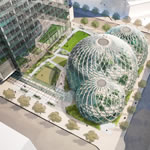
The largest of the three spheres will be 130 feet in diameter and have an interior volume of 1.15 million cubic feet. The smallest will be around 80 feet in diameter with a volume of 268,082.6 cubic feet.
Who wouldn’t want to work in a biosphere? Just imagine all the Biodome jokes. Although often a controversial architectural form, the idea of a sphere has persisted throughout time, and in the case of NBBJ’s development plan for Amazon’s Seattle headquarters, it’s perfectly synecdochical for our global biosphere. Announced in fall 2012 with a projected 2016 delivery date, the botanical, greenhouse-style LEED Gold biospheres are situated in the center of Amazon’s upcoming 3.3 million-square-foot high-rise complex in Denny Triangle. Reimagining the original proposal of a standard, six-story office building as a portion of the development, the three interlocking biospheres, ranging in height from 80 to 95 feet, will total 65,000 square feet of flexible, five-story, transparent office space.
Structurally sound by virtue of their form, the spheres will have exteriors composed of multilayered glass supported by a metal framework and will be located in a larger semi-public green space, the figurative center of the high-profile complex. Plantings within the spheres will have native flora, controlled air quality, and contribute to a healthy work environment, and the volumes are intended to allow the planting of matured local trees. Retail spaces will anchor the ends of the biosphere complex, serving to connect the campus to the community and vitalize the streetscape. Like other major global brands, such as Facebook, Apple, and Adobe, Amazon’s new campus will be at once iconic, functional, and enviable.

